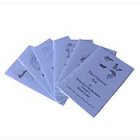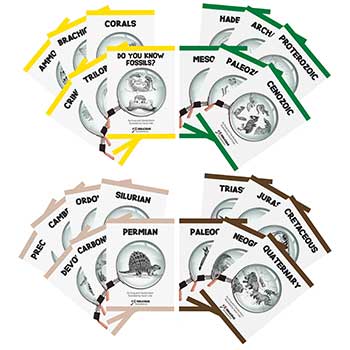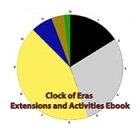Sign up for Lesson Plans, discounts & more!
Earth Science Lesson Plans
The Proterozoic Era
Notes for the leader/teacher on The Earth science lesson plans The Proterozoic: Compared to the previous two lessons, we are now actually using the word “ERA.” This is because it is the first truly geologic time period. As you continue with this lesson, continue to give impressions rather than detailed descriptions. In some ways, this is the most “language-filled” lesson as it tells a complex story. Still, the story is told simply, leaving room for the imagination. Dialogue for the lesson is included in bold and italics. Things you would do during the lesson are in CAPITAL LETTERS.

- A clock of eras chart.Click here for a printable version.
- A blank or non-colored chart Click here for a printable version
- Loose pieces for each of the Eras (You’ll use the first three sections in this lesson: The Hadean, Archaean, and the Proterozoic.)
- An arrow to use as the hand on the Clock of Eras
- (Optional: A large, black poster board or construction paper to use as a background.)
- Templates for student follow-up
- Review the Previous Lessons
- (SHOW THE COLORED CLOCK OF ERAS WITH THE ERA HAND.) What are these? The clock of Eras shows us the time since the Earth was formed and the hand marks the Eras.
- (REMOVE THE COLORED CLOCK AND REPLACE IT WITH THE BLANK CLOCK.)
- (ADD THE HADEAN SECTION.) Do you remember this section? The Hadean Time was the time of the volcanoes forming the Earth’s crust. There was no life on the planet yet, so it is black.
- (ADD THE ARCHAEAN SECTION.) Do you remember the next section? The Archaean Time. When the volcanoes exploded they formed huge clouds around the Earth. The clouds dumped so much water on the Earth that the oceans were formed. This was the time of the Bubble and Thinkers in the oceans. These first “sort-of” cells were called cyanobacteria. Their important job was to create oxygen.
- (SHOW THE PROTEROZOIC SECTION.) As time marches on, a new era begins. This is the Proterozoic Era. The long period of bubble-thinker experiments has created real cells with real memory. The Proterozoic Era is yellow on the Clock of Eras to remind us of the work of the sun.
- The sun formed a partnership with the cyanobacteria that had formed during the Archaean Time. They worked together to put oxygen into the atmosphere around the Earth.
- The oxygen-rich atmosphere was all that was needed for life to begin, but there was another problem in the oceans.
- All this time, rain still falls on the Earth. The Earth is getting cooler. In the seas, there is a build-up of minerals. It is hard for the baby cells to survive in the salty mineral water. They feel afraid and angry at the salts for polluting their watery home.
- The salts explain that they were pushed into the seas by droplets of water that fell on the mountains and hurried down the sides into the seas. So the frightened cells cry out at the water droplets to stop bringing the salt into their watery home.
- The water droplets explain that water always seeks the lowest level. Because they had been dropped on the mountain tops, they had to flow to the seas. So the little cells look angrily at the wind and demand to know why it had carried the water to the tops of the mountains.
- The wind explains that it is doing its job, too. It must move the heat from the belly of the Earth to the colder feet at the mountain tops. During its work, the water vapor climbs on its back. This works well until they reach the cold mountain tops. By then the water vapor turns to liquid and becomes too heavy to carry. “The water must fall back to the Earth,” the wind explains.
- The tiny life cells look around for something else to help them solve their problem. Even the Sun is not able to help the cells get rid of the salts. But remember, the cell came about after thousands of years of bubble-thinker experiments. They are inventors at heart!
- A new type of cell appears that can eat the poisonous salts. The tiny new animal uses the salts to build protective shells around their bodies. There are so many of these foraminiferans that more than a third of the ocean bottom is made up of their remains. Rocks on the ocean floor contain fossils of their shells, letting us know about their important work. The foraminiferans saved the cells from a salty death. More importantly, they saved life from extinction before it could begin!
- Atmospheric oxygen experiment
Check out some of the Educational Materials for sale on our sister site fossilicious.com.

interested in more? If so, you may want to check out our other sites:
fossilicious.com - Our online fossil and mineral rock shop.
rocksandminerals4u.com - An educational site about rocks, minerals, and geology.
Geologic Time Geologic Time Line
Cenozoic Era
Quaternary
Neogene
Paleogene
Mesozoic Era
Cretaceous
Jurassic
Triassic
Paleozoic Era
Permian
Carboniferous
Devonian
Silurian
Ordovician
Cambrian
Archean Time
Hadean Time
Teachers Resources
Activities for Education and Fun
Earth Science Lesson Plans
Activities For Kids
Fossil Lesson Plans
Fossil Activities
Education Articles
Coloring Pages
Dinosaur Coloring Pages
Montessori Materials
Geology Club
Fossil Hunting
 |
 |
 |




